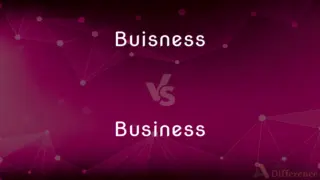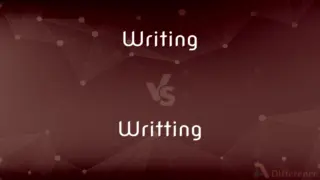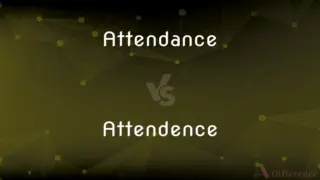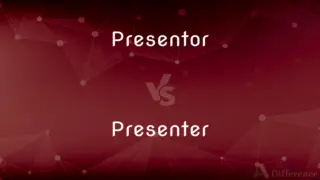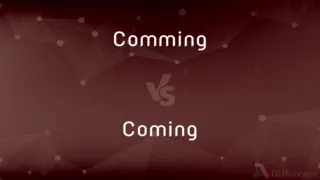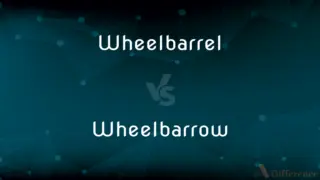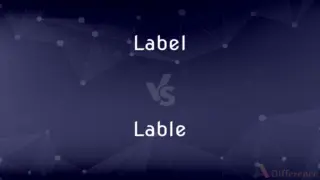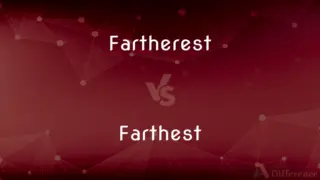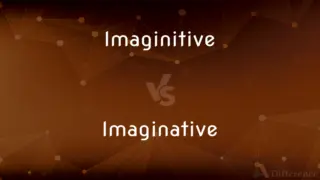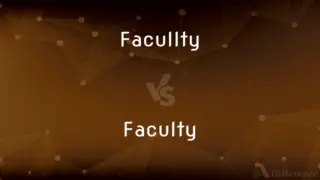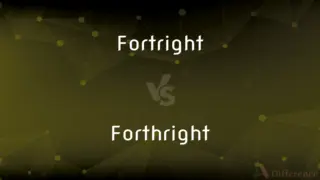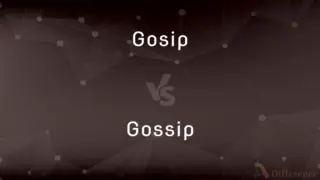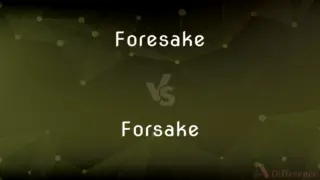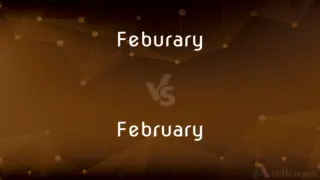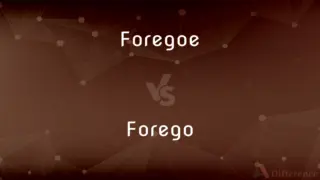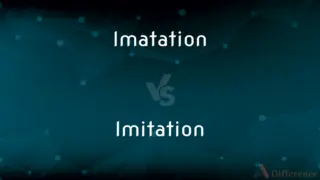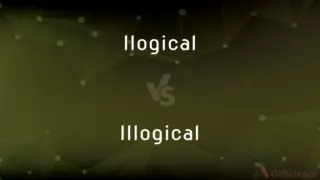Piocene vs. Pliocene — Which is Correct Spelling?
By Tayyaba Rehman — Updated on April 2, 2024
"Piocene" is an incorrect spelling; "Pliocene" is correct, referring to an epoch in the geologic timescale.
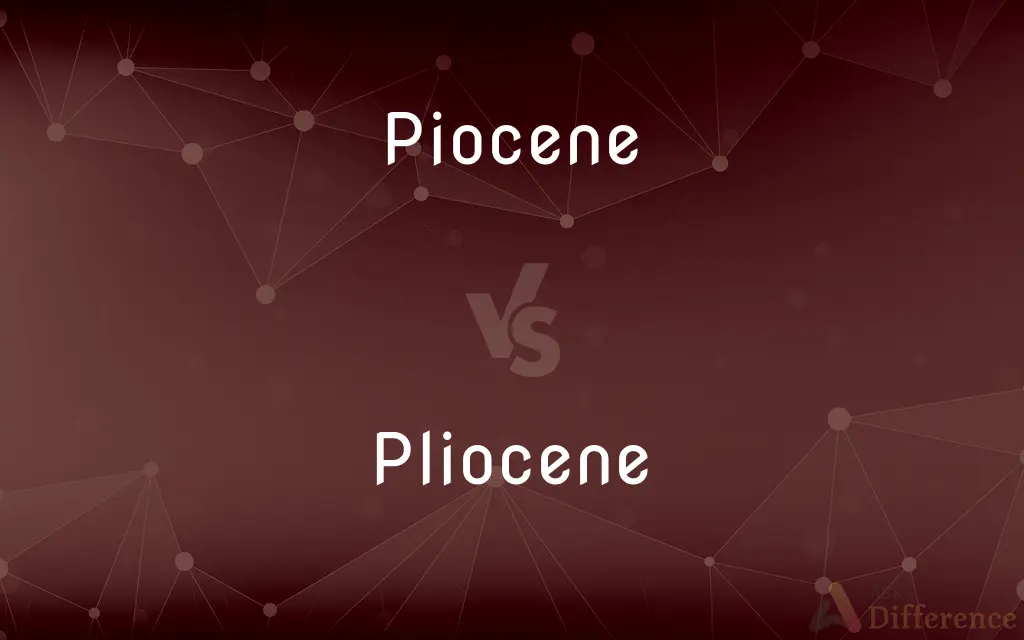
Table of Contents
Which is correct: Piocene or Pliocene
How to spell Pliocene?

Piocene
Incorrect Spelling

Pliocene
Correct Spelling
ADVERTISEMENT
Key Differences
Recall "Plio-" is a prefix in geology terms.
Link "Pliocene" with "Miocene," the epoch before it, both having "i" before "ocene."
Remember it with the visual of layered earth (plies of earth) to denote geologic epochs.
Think of "Pli" in "Pliocene" resembling the word "Ply."
Use mnemonic: "Please Learn It: Pliocene Epoch."
ADVERTISEMENT
How Do You Spell Pliocene Correctly?
Incorrect: Fossils from the Piocene are crucial for understanding human evolution.
Correct: Fossils from the Pliocene are crucial for understanding human evolution.
Incorrect: During the Piocene Epoch, the climate was much warmer than today.
Correct: During the Pliocene Epoch, the climate was much warmer than today.
Incorrect: The continents were almost in their present positions by the Piocene.
Correct: The continents were almost in their present positions by the Pliocene.
Incorrect: Marine life was abundant and diverse in the Piocene seas.
Correct: Marine life was abundant and diverse in the Pliocene seas.
Incorrect: The Piocene period saw the rise of many modern mammal families.
Correct: The Pliocene period saw the rise of many modern mammal families.
Pliocene Definitions
Pliocene is an epoch between the Miocene and Pleistocene, around 5.3 to 2.58 million years ago.
The world saw significant climatic changes during the Pliocene.
Pliocene represents an age in the Neogene Period, characterized by cooler and drier climates.
Various species evolved and diversified in the Pliocene.
Pliocene characterizes the geologic epoch after the Miocene and before the Pleistocene.
Fossils from the Pliocene epoch provide insights into past life.
The Pliocene epoch has deposits with important fossils indicating prehistoric life and environments.
Researchers study Pliocene deposits to understand prehistoric flora and fauna.
The Pliocene is significant for understanding the evolution of hominins and their migration.
The earliest human ancestors can be traced back to the Pliocene.
The Pliocene ( PLY-ə-seen; also Pleiocene) is the epoch in the geologic time scale that extends from 5.333 million to 2.58 million years BP. It is the second and most recent epoch of the Neogene Period in the Cenozoic Era. The Pliocene follows the Miocene Epoch and is followed by the Pleistocene Epoch.
Of, relating to, or being the epoch of geologic time from 5.3 to 2.6 million years ago, the most recent epoch of the Tertiary Period. It is characterized by the appearance of distinctly modern animals and by the expansion of grasslands. See Table at geologic time.
The Pliocene Epoch.
Of, pertaining to, or characterizing, the most recent division of the Tertiary age.
The Pliocene period or deposits.
From 13 million to 2 million years ago; growth of mountains; cooling of climate; more and larger mammals
Pliocene Meaning in a Sentence
Many species that lived during the Pliocene are ancestors of modern animals.
The Pliocene featured the formation of the Isthmus of Panama, which greatly affected ocean currents.
The Pliocene Epoch is known for significant changes in Earth's climate and geography.
Scientists study Pliocene fossils to understand how climate change can impact Earth.
The end of the Pliocene marked the beginning of the cooler Pleistocene Epoch.
During the Pliocene, the Himalayas continued to rise, which influenced global climate patterns.
The Pliocene saw the evolution and spread of early hominins, our distant ancestors.
The Pliocene was a time when grasslands expanded, affecting the evolution of many grazing animals.
Forests in the Pliocene were home to a wide variety of plant and animal life.
The climate of the Pliocene was warmer and more humid than the current climate.
The shifting of continents during the Pliocene helped shape the global environment.
The Pliocene Epoch contributed to the diversification of marine life due to changing sea levels.
Pliocene ecological changes prompted adaptations in many species, leading to new forms of life.
Fossil records from the Pliocene help scientists understand the evolution of the natural world.
Marine fossils from the Pliocene provide evidence of higher sea levels than today.
Pliocene oceans were teeming with life, including many species of sharks and whales.
Researchers use Pliocene sediment cores from the ocean floor to study past climates.
The Pliocene included periods of volcanic activity that affected the planet's atmosphere.
The cooling trend that began in the Pliocene led to the ice ages of the Pleistocene.
The landscape of the Pliocene was varied, with vast plains, mountains, and shrinking forests.
The Pliocene provides crucial evidence for the study of plate tectonics and continental drift.
The Pliocene was a period of relative geological stability, with fewer mass extinctions than other epochs.
Pliocene deposits are rich in the fossils of mammals, birds, and other vertebrates.
Human ancestors began to exhibit bipedalism more frequently during the Pliocene.
Many modern plant species trace their origins back to the Pliocene.
Pliocene Idioms & Phrases
Pliocene climate
The general weather conditions that prevailed during the Pliocene Epoch.
The Pliocene climate was warmer, leading to less ice at the poles.
Pliocene layers
Geological strata that were formed during the Pliocene Epoch.
The Pliocene layers in this area are rich in fossilized sea creatures.
Common Curiosities
Why is it called Pliocene?
It's named "Pliocene" from the Greek words for "more recent" because it is more recent than the Miocene.
Which vowel is used before Pliocene?
The vowel "e" is used before Pliocene in adjectives like "early Pliocene."
What is the verb form of Pliocene?
There isn't a verb form for "Pliocene."
What is the pronunciation of Pliocene?
Pliocene is pronounced as /ˈplaɪ.ə.siːn/.
What is the singular form of Pliocene?
Pliocene.
Which preposition is used with Pliocene?
Commonly "during" as in "during the Pliocene."
What is the plural form of Pliocene?
Pliocenes (though rarely used in this form).
Is Pliocene an adverb?
No.
Is Pliocene an abstract noun?
No.
What is the root word of Pliocene?
The root is derived from Greek "plio-" (more) and "ceno-" (new or recent).
Is Pliocene a collective noun?
No.
Is the Pliocene term a metaphor?
No, it refers to a specific geologic epoch.
Is Pliocene a countable noun?
No.
Which determiner is used with Pliocene?
Determiners such as "the," "this," or "that" can be used based on context.
Which conjunction is used with Pliocene?
It can vary based on context, but "and" can be used, as in "Pliocene and Pleistocene epochs."
Is the word Pliocene imperative?
No.
What part of speech is Pliocene?
It can be both a noun and an adjective.
Which article is used with Pliocene?
Both "the" and "a" can be used, depending on context.
Is Pliocene a negative or positive word?
It is neutral; it refers to a specific epoch.
Is Pliocene a vowel or consonant?
It's a word that begins with a consonant.
What is another term for Pliocene?
It is uniquely termed. Closest would be "Pliocene epoch."
What is the opposite of Pliocene?
There's no direct opposite, but in terms of geologic time, epochs before or after can be contrasted with it, e.g., Miocene or Pleistocene.
Is Pliocene a noun or adjective?
Pliocene can be both a noun (referring to the epoch) and an adjective (describing something of or relating to that epoch).
Is the word “Pliocene” a Direct object or an Indirect object?
It can function as a direct object, e.g., "She studied the Pliocene."
How do we divide Pliocene into syllables?
Pli-o-cene.
What is the first form of Pliocene?
Pliocene.
What is the second form of Pliocene?
There isn't a second form as it's not a verb.
What is the third form of Pliocene?
There isn't a third form as it's not a verb.
How is Pliocene used in a sentence?
"The Pliocene epoch witnessed significant climatic changes on Earth."
Is the word Pliocene a gerund?
No.
How many syllables are in Pliocene?
Three.
What is the stressed syllable in Pliocene?
The first syllable, "Pli."
Share Your Discovery

Previous Comparison
Penience vs. Penance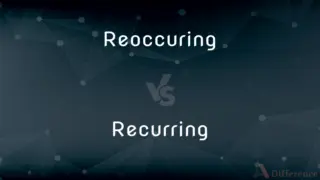
Next Comparison
Reoccuring vs. RecurringAuthor Spotlight
Written by
Tayyaba RehmanTayyaba Rehman is a distinguished writer, currently serving as a primary contributor to askdifference.com. As a researcher in semantics and etymology, Tayyaba's passion for the complexity of languages and their distinctions has found a perfect home on the platform. Tayyaba delves into the intricacies of language, distinguishing between commonly confused words and phrases, thereby providing clarity for readers worldwide.













